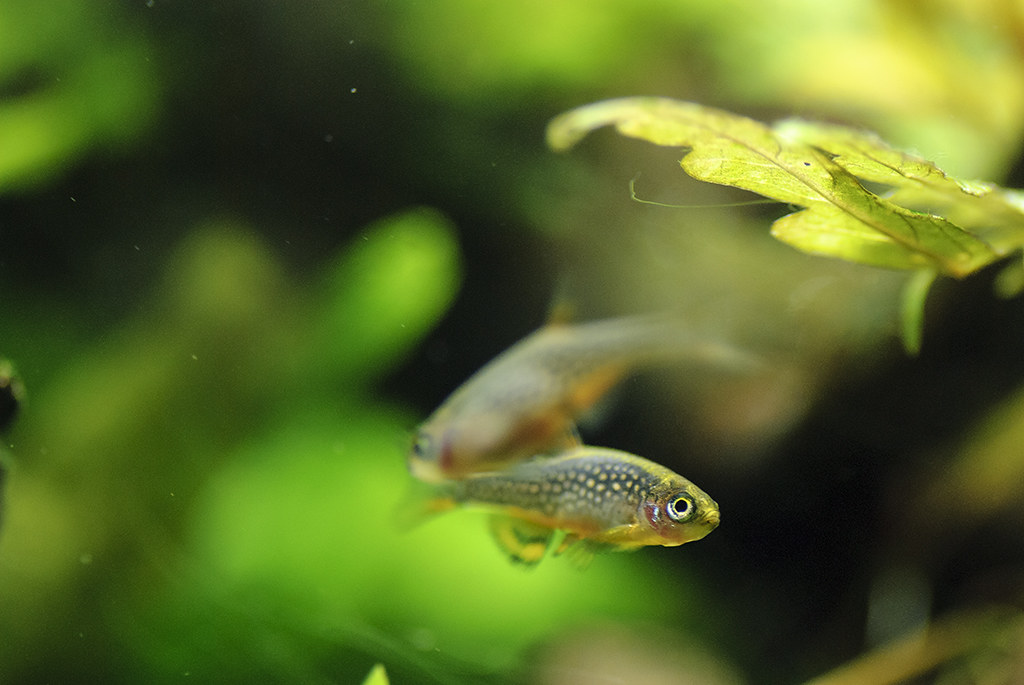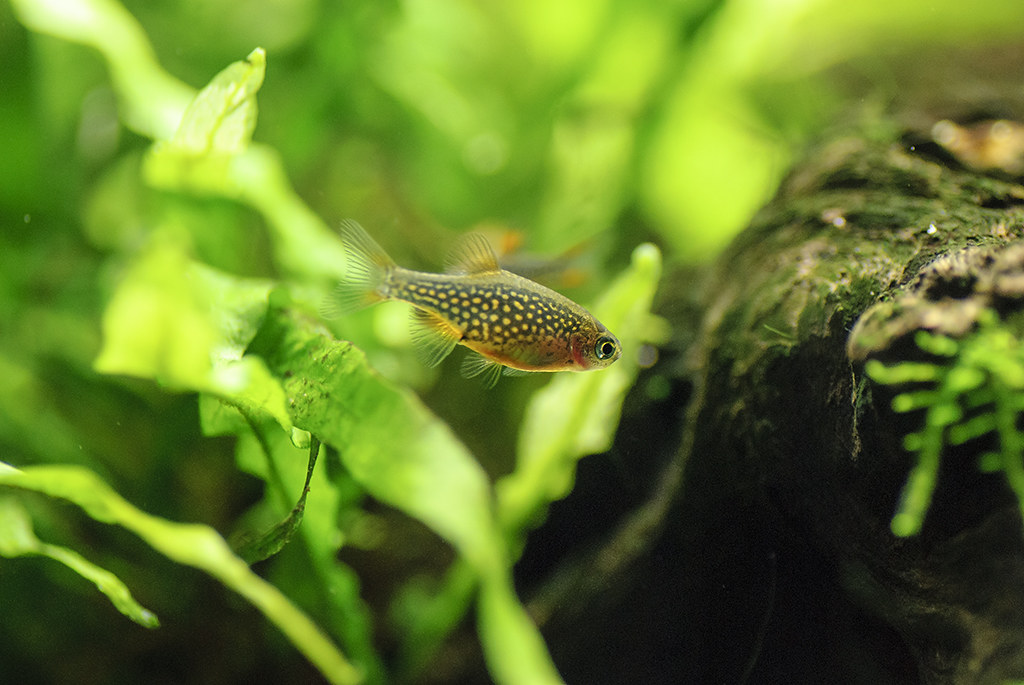Celestial Pearl Danio
The breathtaking allure of the Celestial Pearl Danio – Danio margaritatus, also familiar as Galaxy Rasbora, swept across the internet over a decade ago through a single photograph. Initially, many hobbyists questioned its authenticity thinking it was simply too stunning to have escaped the global aquarium community’s attention. However, the area of origin for this species had been inaccessible to western explorers for quite some time.
- Experience Level: Beginner
- Hardiness: Hardy
- Minimum Tank Size: 15 gal (55 L)
- Maximum Size: 1 inch (2.5 cm)
- Temperament: Peaceful
- Temperature: 73 – 79° F (23 – 26° C)
- pH Range: 6.5 – 7.5
- Water Hardness: 2 – 10 dGH
- Diet: Omnivore
Table of Contents
Introduction
Size and Appearance
Care Guide
Tank Mates
Diet and Feeding
Breeding
Unveiled to the world in late September 2006, the striking image of the Celestial Pearl Danio set the Internet abuzz among tropical aquarium enthusiasts. The discovery befuddled many experts as they sought to classify this unique species to an accurate genus.
Initially, they categorised it as Celestichthys Margaritatus, signifying “a celestial fish decked with pearls”. Due to its striking resemblance to the Microrasbora erythromicron, the Celestial Pearl Danio was initially sorted under the genus Microrasbora.
The Celestial Pearl Danio’s beauty left many awestruck, with some strategically assuming that the photographic images were doctored in some way. These small, spectacular fish display an array of colorful details packed into a petite, rounded frame resulting in an awe-inducing visual marvel.
Size and Appearance
Measuring approximately 1 inch (2.5 cm) as mature adults, these miniature danionins reach maturity and maximum size by the age of three months. The males are graced with strikingly deep navy blue bodies, speckled with small pearl-esque spots, creating a pattern that resonates with their namesake galaxy. In contrast, the bright orange to red ventral fins create a striking contrast to their blue frames. All of them, save for pectoral fins, are outlined in a similarly deep blue or black.
In comparison, female colours are less vibrant, presenting a green-blue with a bronze sheen, rather than deep midnight blue. The tiny pearl dots are less distinct, and their fins exhibit a more diluted colour compared to males. Furthermore, the ventral fins of the females are transparent.
Care Guide
- Minimum Tank Size: 15 gal (55L)
- pH Range: 6.5 – 7.5
- Water Hardness: 2 – 10 dGH
- Temperature: 73 – 79° F (23 – 26° C)
- Lighting: Low to Moderate
- Substrate: Fine, dark sand/gravel
- Brackish: No
- Water Flow: Weak/Low
- Tank Region: All areas
Very little is known regarding the exact water conditions in their natural habitat. Some reports suggest near-neutral waters with minimum carbonate content and low conductivity.
Fish-keepers globally have successfully nurtured and bred this species in a diverse range of water conditions, including soft acidic water and hard alkaline water. Thus, maintaining pristine water seems key to successful Celestial Pearl Danio care. Regular water changes and controlling dissolved organic content is essential. While precise water conditions may vary, many aquarium enthusiasts have reported thriving stocks maintained in ranges similar to the species’ cousin, the White Cloud Mountain Minnow.
The major health concern for this species is fin rot, often originating from male disputes. Injured fish are particularly at risk, especially in subpar water conditions. Proactive fin rot prevention is vital but, if an infection does occur, it quickly spreads and can be challenging to treat. Severe cases can lead to secondary infections and fatalities. However, with prompt intervention, fin rot can be successfully treated at home using antibacterial treatments if caught at the early stages.
Provided they receive optimal care, Celestial Pearl Danios can survive as long as five years in a captive setting. Several factors can negatively impact their lifespan, including bullying tank mates and improper water quality.
Suites for an adult size of just an inch, Celestial Pearls may seem perfect for a nanopad on your desktop. However, due to their aggressive tendencies during courtship, the environment should only cater to a sole male. Given their aggressive intra-species behavior, the subdominant males require a safe haven away from the dominant males to prevent fatal encounters.
The best solution for this species is a 15-gallon tank for a group of six Celestial Pearl Danios. To accommodate additional fish, an even larger tank may be required with approximately two gallons of extra water capacity for every additional Celestial Pearl Danio.
Celestial Pearl Danios are native to densely vegetated ponds. Despite the slow water movement, the rich flora oxygenates the water and offers numerous hiding spots. Generously landscaping your tank with aquatic plants can help mitigate hostility as these act as barriers breaking the visual contact between aggressive males.
Gravel is the go-to substrate for a planted aquarium as it permits water flow, reducing the risk of harmful bacterial and mold build-up that could jeopardize your fish. Soil isn’t necessary and using a mineral-enriched substrate is purely optional.
Tank Mates
The ideal Celestial Pearl Danio tank companions are highly adaptable, peace-loving species that won’t perceive your smaller fish as a meal. Great match-ups for your Celestial Pearls include
- Cory catfish
- Endler’s livebearer
- Killifish
- Guppies
- Honey gourami
- Sparkling gourami
- Mollies
- Amano shrimp
- Red cherry shrimp
- Tetras
A 15-gallon tank can comfortably accommodate a Celestial Pearls group of six, ideally with more females to deter male aggression. Depending on the species you try to mix in, you may need a bigger tank.
Feeding Guide
- Diet: Omnivore
- Frequency: Several small feedings per day
- Pellet Foods: Yes, small pellets as they have very small mouths
- Flake Foods: Yes
- Live Foods: Yes
- Meat Foods: Yes
- Vegetable Foods: Yes, crushed into very small pieces
In nature, the Celestial Pearl Danio exhibits diverse dietary habits. When kept in captivity, these fish are content with high-grade crushed flakes and sinking pellets.
Despite their tiny mouths, they have small conical teeth indicating they can prey on small creatures. Alongside commercially available food, supplement their diet with protein-enriched delicacies including freeze-dried krill, fresh brine shrimp hatchlings, daphnia, moina, grindal worms, and tiny white worms.
Breeding
The inaugural successful captive breeding of the Celestial Pearl Danio happened mere weeks after their discovery in the wild. The species was observed to spawn almost daily regardless of whether they were in the wild or in a captive environment.
These species are egg scatterers who don’t provide parental care. A mature female can lay between a dozen to 30 eggs in a single spawning session and the adults, including the parents, may eat the eggs.
To safeguard the eggs from the adults, you should use a spawning grate such as a plastic needlepoint canvas and cover it with plants or acrylic spawning mops. The lightly adhesive fertilized eggs fall to the bottom quickly where they hatch within three days if kept at 76 F (24.4 C). The bottom-dwelling fry will begin swimming within two to four days.
After a week of liquid fish food and crushed commercial fry flakes, the diet can transition to freshly hatched brine shrimp. Rapid growth follows and the juveniles begin displaying their adult coloration from around nine weeks, reaching their full size at about three months.



